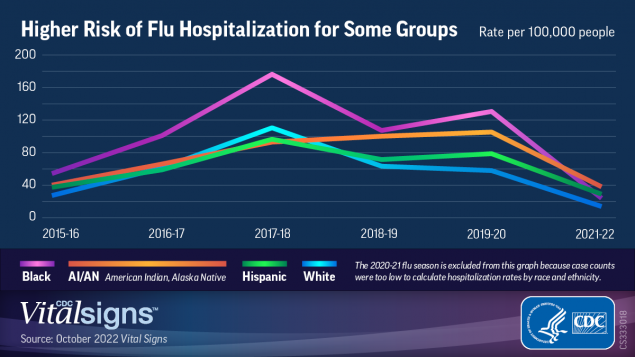
Getty Images/iStockphoto
Public Health Messaging, Equity Key to Getting Flu Shots in Arms
CDC data shows racial health disparities in flu shot rates, as well as lower overall flu shot rates since the pandemic, prompting calls for better public health messaging.
The US will need to leverage strong public health messaging if it plans to increase rates of flu shots and combat the racial health disparities in flu vaccination and hospitalization that has plagued the nation for nearly a decade, according to a new CDC report.
Particularly, the report showed that a little more than half of White and Asian adults got their flu shots during the 2021-2022 flu season, while between 37 and 42 percent of Black, Hispanic, and American Indian/Alaska Native (AI/AN) individuals got the same.
That translated to higher hospitalization rates related to flu, the CDC said. Black people were 1.8 times more likely to be hospitalized with the flu, while AI/AN people were 1.3 times more likely, and Hispanic folks were 1.2 times more likely than their White counterparts.
These findings are alarming, considering experts are already observing an earlier and more severe flu season. Community-based vaccine campaigns and tailored approaches to increasing flu vaccination rates among communities of color will be key to closing the gap between them and their White counterparts.

Racial health disparities in flu vaccination and outcomes are persistent, the researchers explained. And although the annual flu shot is an effective tool against severe illness, there are serious inequities in which racial groups get the shots.
“For example, during the 2019–20 season, influenza vaccination prevented an estimated 7.5 million influenza illnesses, 105,000 influenza-associated hospitalizations, and 6,300 influenza-associated deaths,” CDC researchers wrote. “Persons from some racial and ethnic minority groups experience higher rates of severe influenza and have lower influenza vaccination coverage rates compared with White persons.”
That lower flu vaccination rate has translated to nearly a decade of worse health outcomes for Black, Hispanic, and AI/AN people, the researchers said. Looking at flu outcomes data from FluServ-NET and vaccination data from the Behavioral Risk Factor Surveillance System (BRFSS), the researchers found that lower vaccination rates among racial and ethnic minorities have resulted in higher flu hospitalization rates.
To be clear, more people are getting the flu shot regardless of race, with the proportion of adult flu shots increasing from 40.5 percent to 49.4 percent between the 2010-2011 season and the 2021-2022 season. The only racial group that did not see increased flu vaccination rates was AI/AN adults.
Even still, some racial groups are lagging behind. During the 2021-2022 flu season, as many as 53.9 percent of White people got their flu shots, but only 40.9 percent of AI/AN, 37.9 percent of Hispanic, and 42 percent of Black people got the shots. Another 42.6 percent of individuals identifying as multiracial or other races got the flu shot.
These lower rates of vaccination are translating to higher rates of flu hospitalization. From the 2009-2010 season into the 2021-2022 season, hospitalization rates per 100,000 adults were 78.2 for Black people, 54.6 for AI/AN people, and 50.3 for Hispanic people.
That’s a far cry from the 43 per 100,000 adult hospitalizations among White people and the 34.5 for Asian or Pacific Islander (API) folks, the CDC said.
Public Health Messaging to Improve Flu Vaccination Rates
Ultimately, work to reduce costly flu hospitalizations comes down to the public health campaigns related to the flu shot. Post-pandemic, flu vaccine rates have been lower across all racial groups, adding some urgency to this latest flu season that experts are saying is coming earlier than normal.
The US saw a 0.8 percentage point decrease between the 2020-2021 and 2021-2022 flu seasons, regardless of race, the CDC reported. The decrease may have been driven by White people, with the researchers observing a 1.6 percentage point decrease during that period. Flu vaccination rates remained stable for all other racial groups from the 2018-2019 season into the 2021-2022 season.
Healthcare and community-based organizations will need to lean into public health messaging best practices to support better flu vaccination rates.
“Following the standards for adult immunization practice, providers should assess patient vaccination status at all medical visits and offer (or provide a referral for) all recommended vaccines,” the CDC wrote. “Meeting this standard in a culturally responsive manner could help reduce observed disparities in vaccination coverage.”
Like other recent vaccine campaigns, the CDC recommended patient-provider communication strategies to instill trust. Healthcare providers should use empathy to understand patients’ fears or concerns about getting the flu shot and counsel patients about the benefits of the shots.
Some data has also shown that patient engagement technologies, like automated patient outreach tools and the patient portal, have been effective at notifying patients that they are due for their annual flu shots. These tools can use self-scheduling systems to let patients pick appointments that are convenient to them.
To promote health equity, community engagement will be necessary, CDC added. Making shots available in community settings, leveraging trusted community messengers, and issuing patient education materials that combat misinformation will be helpful.
Such efforts should reflect cultural norms or values and use accessible channels, like social media and community leaders, the agency advised.
“National, tailored influenza vaccination campaigns can reinforce local efforts to increase awareness of the importance of influenza vaccination among target audiences to encourage increased vaccination coverage among these groups,” CDC concluded.





